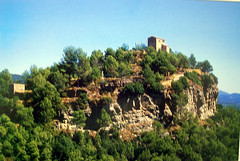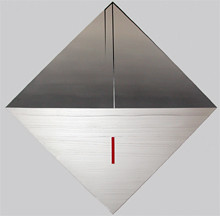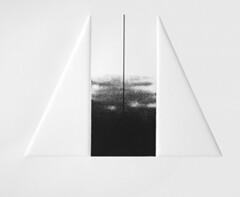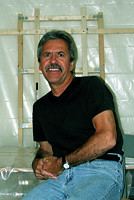Dan Ramirez in Gallifa/ Victor M. Cassidy
Dan Ramirez in Gallifa
ArtNet.com
1/22/03
Victor M. Cassidy
Dan Ramirez, one of Chicago's premier mid-career artists, has created a visual language of great beauty and clarity. In his acrylic paintings, we see formal, geometric arrangements of vertical lines and blocks in pure color. The surface is flat and there's little suggestion of depth, but the color often fades slowly from one end of a block to the other.
Ramirez claims to be inspired by philosophy or music, but it's not always easy to connect his imagery to its sources. "TL-P," a body of paintings from the 1970s, responds to Ludwig Wittgenstein's Tractatus Logico-Philosophicus. Ramirez made etchings in the '80s that he related to the music of the French composer Olivier Messiaen.
In summer of 2002, Ramirez was an artist in residence at the Fundacio Tallers Joesp Llorens Artigas in Gallifa, a town near Barcelona in Spain. He worked there with Joan Gardy Artigas, a Spanish artist who is best-known for his 20-year ceramic collaboration with Joan Miró. Inspired by this new environment, Ramirez produced three suites of acrylic paintings on paper, which he showed at Printworks in December.
This is the first time within memory that Ramirez has put a brush to paper. The new work, which employs his familiar imagery is now enriched with brush strokes. While these works still have literary sources, they are more relaxed and approachable than his paintings -- and easier to read.
The "Gallifa" suite, for example, responds to the spectacular mountainous terrain in the town where the artist worked with imagery that suggests water and sky glimpsed through an open window. The "Veronica" suite, all rich reds and blacks, results from Ramirez' attendance at bullfights. A Veronica is a maneuver in which the torero diverts the bull's charge with his red cape.
The "Majestat Batalló" suite responds to a 12th-century Romanesque crucifix (unusual because it shows a clothed Christ) that the artist saw in the nearby Museu Nacional D'Art de Catalonia. Ramirez will return to the Gallifa workshop this summer for his first experience of ceramics. We await the results with enthusiasm.





